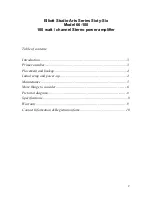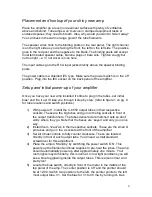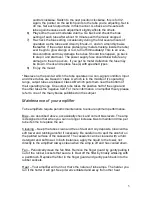
5
control clockwise. Switch to the next position clockwise, this is for V2.
Again, the pointer on the switch points to the tube you’re adjusting. Set to
40 ma. Set each output tube in this manner. Go back and re-set each
tube again because each adjustment slightly affects the others.
6) Play some music at moderate volume. Go back and check the bias
setting of each tube after about 10 minutes with the music stopped.
7) Re-check the bias setting occasionally during the first several hours of
operation as the tubes and c
ircuitry ‘break-in’, and on a monthly basis
thereafter. If the output tubes plates (gray metal structure inside the tube)
ever begin to glow orange or red, turn off immediately! This
is an over-
bias condition and may damage the tubes. Should this happen, go back
to step 3 and start over. The power supply fuse should blow before any
damage to the amp occurs. If you get no meter deflection the fuse may
be blown. Check and replace fuse(s) with specified types.
8) Enjoy the music!
*Bias level is the point at which the tube operates in a non-signal condition. Input
and driver tubes are biased in ‘class A’ which is in the middle of it’s operating
range, output tubes are biased ‘class AB’ which puts them near the bottom of
their operating range. One output tube takes the positive half of the signal and
the other takes the negative half. For more information on amplifier theory please
refer to one of the many books published on the subject.
Maintenance of your amplifier
Tube amplifiers require periodic maintenance to ensure optimum performance.
Bias
– As described above, occasionally check and correct bias levels. The amp
is designed so that when you can no longer increase bias to maintain 40ma. per
tube it’s time to replace the set.
Cleaning
– Keep the tubes clean and free of dust and oily deposits. Clean with a
soft towel and rubbing alcohol if necessary. Be careful not to spill the alcohol on
the painted surface of the casework! The casework can be cleaned with a mild
detergent and soft towel. In both instances, apply the liquid to the towel, not
directly to the amplifier! Always clean when the amp is
off
and has
cooled down
.
Fan
– Periodically clean the fan filter. Remove the finger guard by gently pulling it
out of the rubber sockets that secure it. Dust off the filter by briskly whisking with
a paintbrush. Replace the filter in the finger guard and gently push back into the
rubber sockets.
Heat
– Your amplifier will run hot, that’s the nature of tube amps. The harder you
run it the hotter it will get. Keep it well ventilated and away from other heat
Summary of Contents for 66-100
Page 1: ......










